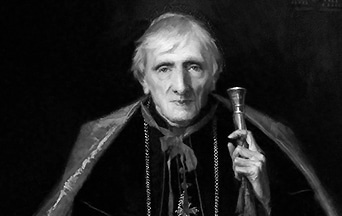
The Oxford Movement developed rapidly, thanks mainly to the success of the Tracts for the Times and John Henry Newman’s St. Mary’s lectures. Each new tract edged the Movement closer to the Catholic Church. It was increasingly evident that Newman and most of his diligent young disciples would eventually convert.
Newman desperately tried to avoid that outcome. Seeing Anglicanism’s imminent “debacle,” he sought to forestall his conversion with two theories that briefly seemed to answer his doubts and fully satisfy his companions’ longings. He called them “the middle way” and “branch theory.”
Theories that Proved Insufficient
At first, the Oxford Movement tried to map out a “middle way” between Protestantism and Catholicism, “holding against the former the authority and tradition of the ancient Fathers, and rejecting the latter’s doctrines that seemed to be innovations.” Newman applied himself to studying the Fathers of the Church. He eagerly sought within Catholic tradition reasons that would allow him to remain an Anglican despite everything.
The Oxford Movement promoted itself as a starting point of major religious reform in England’s official church. The “branch theory” was an outgrowth of Newman’s “middle way.” It attempted to explain the relationship between Catholicism, Anglicanism and the Greek “Orthodox” schism. True Catholicism would be only one, the same as the ancient Fathers, but Newman divided the Church into three branches: Roman, Anglican, and Greek. In Newman’s formulation, each was the authentic church in the regions it dominated. Therefore, each branch should maintain good relations with the other two. Under this theory, it would be wrong for one of the branches to invade the territories of the other two. In this sense, Newman argued, the Catholic Church had committed a breach by carrying out apostolate in England.
Eternal and Natural Law: The Foundation of Morals and Law
Catholic Father Nicholas Wiseman entered into the new terrain of Newman’s argument. In his London lectures and articles in the Dublin Review—in which he had worked with Catholic politician Daniel O’Connell—he fought Newman’s theories using the Tracts’ own weapons. The arguments he drew from the works of Church Fathers and the history of the early centuries of Christianity showed that the Oxford Movement’s position was untenable. One of Father Wiseman’s articles laid bare the foundations of the construction the Oxford Movement had built and particularly impressed Newman.
The Search for Truth Leads to the Church
In the autobiographical Apologia Pro Vita Sua, written after his conversion, the future Cardinal Newman confesses that he realized the inanity of the “middle way” when studying Monophysitism.1
“My stronghold was Antiquity; now here, in the middle of the fifth century, I found, as it seemed to me, Christendom of the sixteenth and the nineteenth centuries reflected. I saw my face in that mirror, and I was a Monophysite. The Church of the Via Media was in the position of the Oriental communion, Rome was, where she now is; and the Protestants were the Eutychians.”2
Newman discovered another way in which his “branch theory” could not be the powerful weapon against Catholicism he had hoped. He saw that the Anglican Church had violated the theory when it created an Anglican diocese with its seat in Jerusalem. The diocese was created to oversee all the Protestant sects of the East.
 Learn All About the Prophecies of Our Lady of Good Success About Our Times
Learn All About the Prophecies of Our Lady of Good Success About Our Times
“This was the third blow, which finally shattered my faith in the Anglican Church. That Church was not only forbidding any sympathy or concurrence with the Church of Rome, but it actually was courting an intercommunion with Protestant Prussia and the heresy of the Orientals. The Anglican Church might have the Apostolical succession, as had the Monophysites; but such acts as were in progress led me to the gravest suspicion, not that it would soon cease to be a Church, but that, since the sixteenth century, it had never been a Church all along.”
Newman’s Official Conversion to the True Church
This evolution of the Oxford Movement was evident in the published Tracts. The gradual shift naturally provoked reactions from Anglicanism’s official bodies. When Tract 90, which practically repudiated Protestantism, came out, the Oxford Council condemned it. Several Anglican bishops received special mandates to monitor the University. Newman left the University and retired to Littlemore, a village outside of Oxford. In 1845, he began writing his Essay on the Development of Christian Doctrine. His research work for that work completed his conversion. On October 3, 1845, he officially resigned from the University of Oxford. Five days later, he abjured Protestantism before Fr. (now Venerable) Dominic of the Mother of God, Superior of the Passionists in England.
Newman’s conversion brought large numbers of Anglicans into the Church. Some of these converts became the most celebrated English Catholics of the nineteenth century.
Science Confirms: Angels Took the House of Our Lady of Nazareth to Loreto
The story of Newman’s conversion has an interesting postscript. The Passionist Congregation was founded at the end of the eighteenth century by Saint Paul of the Cross, who prayed uninterruptedly for the conversion of England for thirty years. His rules also required Passionists to pray to God for the northern nations that had abandoned the Catholic Church in the sixteenth century, especially England.
One day, as Saint Paul of the Cross went up to the altar to celebrate Mass, his face illuminated with a supernatural light, and he wept copiously throughout the Sacrifice. At the moment of communion, he went into ecstasy. Afterward, his disciples asked him what graces he had received. He replied: “Oh! My sons, this morning I have seen such admirable things in England! Yes, yes, very wonderful things! I have seen my sons in England!” And when pronouncing these words, he fell again into ecstasy.
Fr. Dominic, who received Newman into the Church, had crossed the English Channel in 1842 to create the first Passionist house in that country.

